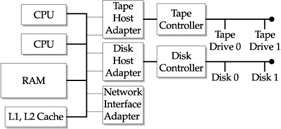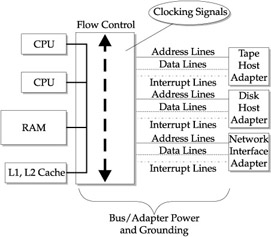Connections: Getting on the Bus
| |
Internal traffic within a computers motherboard is handled through a set of fast connections etched into the circuitry , enabling transfer of data to and from the CPU and internal temporary data locationsfor example, RAM, cache, and CPU registers. The connectivity for external (external to the motherboard) hardware is handled through the edge (of the board) as an expansion to the board. Take a look at Figure 7-1, which shows a universal computer bus.

Figure 7-1: A universal computer bus
These connections to the outside world (external to the motherboard) are referred to as expansion buses and I/O channels. They provide hardware attachment mechanisms that extend the system capabilities beyond what is on the motherboards. This is where I/O devices are connected and, as we discussed earlier, where the host adapter components are attached. It is here where we require our first transfer ticket provided by the host adapters, to get from one bus to the other. As the internal components require a bus to connect to each other, the I/O devices also have that same need. As Figure 7-1 illustrates, the internal bus, I-bus, is adapted to the I/O bus, each transferring and controlling data for the connected components . Each bus controls devices with different mechanisms, different timings, and capacities .
The buses provide the following fundamental functions. As we can see, these are largely electronic mechanisms that do their work internally through a host of components. As we will explore later, the bus mechanisms must be able to work with particular devices that speak their language and have common electronic traits to move data.
Underlying all these sophisticated and complex electronics are several fundamental elements that make up the characteristics of the I/O bus, as shown in Figure 7-2. These include: throughput (commonly referred to as bandwidth), address space (how wide the bus is), interrupt processing (or can I react to external events and change processing modes?), and electro-mechanical attributes, such as how long can I be before my signal is degraded, and am I a circuit board or a backplanein other words, will I connect to the motherboard or will the motherboards connect to me.

Figure 7-2: The internal functions of a typical I/O bus
Bandwidth
Bandwidth is the amount of information the bus can transport during a given time. This is usually measured in MB per second. This is a derivative of clock speed and data width. In other words, a bus using a 5MHz clock speed and a 4 byte data width has a throughput, or bandwidth, of 5 — 4 = 20MB per second. Keep in mind this is what is called aggregate throughput; it is reduced by protocol overhead. We will discuss real speeds in more detail later in the chapter.
Addressing
The address space provides the capability to determine unique identities for source and destination of communications within the bus itself. This is determined by the width of the address component; the larger the address space, the more device operations can be supported. Generally , most buses operate today with 32-bit addressing architectures, providing an address space of 4GB. (This is important if you are working with older bus technology or an advanced technology such as InfiniBand or Fibre Channel; see Part V.)
Interrupt Functions
An external event may occur at any time and the bus must be able to take action in order to continue processing. This interrupt processing is the fundamental concept behind the interactive systems processing that must occur with multiuser, multitasking workloads. The I/O bus must be capable of interruption of a data transfer from disk to tape for an event with a higher priority. Be it an error processing routine or a call to read a block of data from an application, without this capability the bus could not be used for interactive applications, instead it could only be used for a single device.
Electro-Mechanical
Internal buses on the motherboard may only be inches long; external I/O connections must extend several feet or meters . These connections are generally some type of shielded cable and will be placed into areas of electromagnetic interference. I/O buses must have attributes that protect the signals integrity while providing an adequate physical extensibility. The cable for an I/O bus is defined with regard to its maximum length, resistance, whether shielded or unshielded .
The motherboard of a computer will have a number of connections or slots that are nothing more than bus connections. Host adapters are connected at these edge points. The other type of connectivity is the backplane (refer to Chapter 6). The backplane can have no other electronics or circuitry than to provide connection points for host adapters. However, a backplane can also be used to connect complete motherboard systems together along a shared bus. These will be used in tightly coupled SMP and MPP systems. They are also becoming popular for use with integrating thin computing nodes (for example, a system- on-board or a motherboard with no peripherals), which entails sharing a common external bus that may be a network or another type of system interconnectused explicitly in something referred to as blade computing. (Refer to Chapter 20 regarding future protocols such as InfiniBand, an external example, and Rapid IO, an internal example.)
| |
EAN: 2147483647
Pages: 192